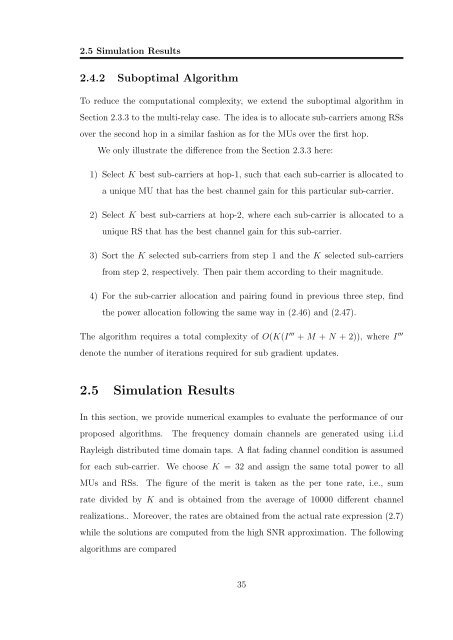Resource Allocation in OFDM Based Wireless Relay Networks ...
Resource Allocation in OFDM Based Wireless Relay Networks ...
Resource Allocation in OFDM Based Wireless Relay Networks ...
You also want an ePaper? Increase the reach of your titles
YUMPU automatically turns print PDFs into web optimized ePapers that Google loves.
2.5 Simulation Results<br />
2.4.2 Suboptimal Algorithm<br />
To reduce the computational complexity, we extend the suboptimal algorithm <strong>in</strong><br />
Section 2.3.3 to the multi-relay case. The idea is to allocate sub-carriers among RSs<br />
over the second hop <strong>in</strong> a similar fashion as for the MUs over the first hop.<br />
We only illustrate the difference from the Section 2.3.3 here:<br />
1) Select K best sub-carriers at hop-1, such that each sub-carrier is allocated to<br />
a unique MU that has the best channel ga<strong>in</strong> for this particular sub-carrier.<br />
2) Select K best sub-carriers at hop-2, where each sub-carrier is allocated to a<br />
unique RS that has the best channel ga<strong>in</strong> for this sub-carrier.<br />
3) Sort the K selected sub-carriers from step 1 and the K selected sub-carriers<br />
from step 2, respectively. Then pair them accord<strong>in</strong>g to their magnitude.<br />
4) For the sub-carrier allocation and pair<strong>in</strong>g found <strong>in</strong> previous three step, f<strong>in</strong>d<br />
the power allocation follow<strong>in</strong>g the same way <strong>in</strong> (2.46) and (2.47).<br />
The algorithm requires a total complexity of O(K(I ′′′ + M + N + 2)), where I ′′′<br />
denote the number of iterations required for sub gradient updates.<br />
2.5 Simulation Results<br />
In this section, we provide numerical examples to evaluate the performance of our<br />
proposed algorithms. The frequency doma<strong>in</strong> channels are generated us<strong>in</strong>g i.i.d<br />
Rayleigh distributed time doma<strong>in</strong> taps. A flat fad<strong>in</strong>g channel condition is assumed<br />
for each sub-carrier. We choose K = 32 and assign the same total power to all<br />
MUs and RSs. The figure of the merit is taken as the per tone rate, i.e., sum<br />
rate divided by K and is obta<strong>in</strong>ed from the average of 10000 different channel<br />
realizations.. Moreover, the rates are obta<strong>in</strong>ed from the actual rate expression (2.7)<br />
while the solutions are computed from the high SNR approximation. The follow<strong>in</strong>g<br />
algorithms are compared<br />
35

















